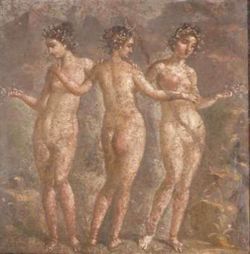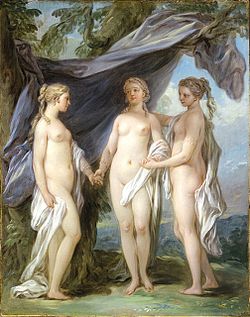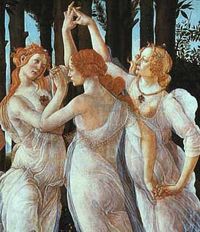خاريتس
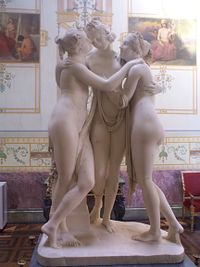
إلهات الحـُسن أو الكارايتات (باليونانية: Χάριτες) بحسب الميثولوجيا الإغريقية القديمة، هن إلهات الجمال، البهاء، الطبيعة، الخصوبة، الرقص، الموسيقى، والإبداع، وهن أيضًا تجسديات لها، ورموز للامتنان واللطف. صاحبت إلهات الحـُسن كلًا من أفروديت وهيرا، وبعضًا من الآلهة الأخرى كهرميز وإيروس، وكن يُعرفن بالإلهات اللاتي يجلبن البهجة إلى الاحتفالات والمناسبات المعينة، والبهاء والتألق أثناء التعامل مع الآخرين، ويمنحن جمالهن وحسنهن لجميع الآلهة والبشر الذين يطمحون إلى السرور في حياتهم.
الاختلافات الإقليمية
في الفن
On the representation of the Graces,
Pausanias wrote,
- "Who it was who first represented the Graces naked, whether in sculpture or in painting, I could not discover. During the earlier period, certainly, sculptors and painters alike represented them draped. At Smyrna, for instance, in the sanctuary of the Nemeses, above the images have been dedicated Graces of gold, the work of Bupalus; and in the Music Hall in the same city there is a portrait of a Grace, painted by Apelles. At Pergamus likewise, in the chamber of Attalus, are other images of Graces made by Bupalus; and near what is called the Pythium there is a portrait of Graces, painted by Pythagoras the Parian. Socrates too, son of Sophroniscus, made images of Graces for the Athenians, which are before the entrance to the Acropolis. Also, Socrates was know to have destroyed his own work as he progressed deeper into his life of philosophy and search of the conscious due to his iconoclastic attitude towards art and the like. All these are alike draped; but later artists, I do not know the reason, have changed the way of portraying them. Certainly to-day sculptors and painters represent Graces naked."
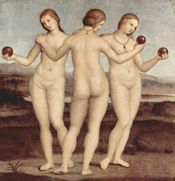
In Renaissance times, the Roman statue group of the three graces in the Piccolomini library in Duomo di Siena inspired most themes.
The Charites are depicted together with several other mythological figures in Sandro Botticelli's painting Primavera (above right). Raphael also pictured them in a painting now housed in Chantilly in فرنسا. Among other artistic depictions, they are the subject of famous sculptures by Antonio Canova and Bertel Thorvaldsen.
A group of three trees in the Calaveras Big Trees State Park are named "The Three Graces" after the Charites.[1]
- List of artwork with images resembling encircled graces
- Anonymous [2]
- Ambrogio Lorenzetti (1348-50) Allegory of Good Government [3]
- Anonymous [4]
- Cosimo Tura (1476-84) detail of Allegory of April [5]
- Sandro Botticelli (1482); detail of Primavera; [6]
- Antonio da Correggio (1518); [9]
- Raphael Sanzio [10]
- Jacopo Pontormo (1535) [11]
- Hans Baldung Grien (1540)
- Jacques Blanchard (1631-33) Man surprising Sleeping Venus and Graces [15]
- Antonio Canova (1799) The Three Graces [18]
- Ludwig Von Hofmann [19]
- Maurice Raphael Drouart [22]
- Jean Arp (September 16, 1886 – June 7, 1966) The Three Graces (1961)
- Kehinde Wiley Three Graces [24]
- Jean-Baptiste van Loo (1684-1745) at the Château de Chenonceau [25]
انظر أيضاً
| Gratiae
]].الهامش
- ^ "The Three Graces", Calveras Big Tree State Park
- ^ Mosaico de las tres gracias
- ^ Allegory of Good Government
- ^ [1]
- ^ Allegory of April
- ^ detail of Primavera
- ^ [2]
- ^ Monument du coeur d'Henri II
- ^ [3]
- ^ [4]
- ^ [5]
- ^ [6]
- ^ [7]
- ^ [8]
- ^ Man surprising Sleeping Venus and Graces
- ^ [9]
- ^ [10]
- ^ [11]
- ^ [http://search3.famsf.org:8080/view.shtml?keywords=three% 20graces&artist=&country=&period=&sort=&start=11&position=12&record=54420]
- ^ [12]
- ^ [13]
- ^ [14]
- ^ [15]
- ^ Three Graces
- ^ Three Graces at Chenonceau
أصل إلهات الحسن
اختلفت الكثير من الأساطير في تحديد أصل إلهات الحـُسن، فبعضها يذكر أنهن:
كانت الصداقة تجمع بين إلهات الحـُسن وإلهات الإلهام، نظرًا لتفضيل إلهات الحـُسن للفنون الشعرية على باقي أنواع الفنون، حيث كان الشعراء يحصلون على إلهامهم من إلهات الإلهام، لكن تطبيق هذه الأشعار في مختلف المناسبات كان من عمل إلهات الحسـُن.
بدايات عبادتهن
يعتقد بأن عبادتهن قد بدأت في بويوتيا، على يد إيتيوكليس، ابن سيفيسوس، وكانت مجموعة من الأحجار تعبد في الأزمان القديمة على أنها إلهات الحـُسن، حيث ساد الاعتقاد أن هذه الأحجار قد سقطت من السماوات في عصر إيتيوكليس.
قائمة بإلهات الحسن
يعتقد بأن تقسيم إلهات الحـُسن إلى مجموعة عوضًا عن فرد يمثل الطرق المختلفة التي يمكن أن ينال بها الشخص البهجة والجمال، كما أجمعت معظم الأساطير أن عددهن ثلاثة، لكن وجدت بعض الأسماء الأخرى، والتي قد تكون مكررة للإلهة نفسها. كذلك، تذكر بعض الأساطير وجود بعض إلهات الحـُسن الصغريات المعنيات بأمور بهيجة أخرى ومتعددة. والأسماء الأكثر شهرة لإلهات الحـُسن هي:
- ثاليا: إلهة الاحتفالات، وكانت تعد أكبر إلهات الحـُسن سنًا.
- آگليا: إلهة الجمال والمجد، وزوجة هفستوس، الذي أنجبت منه أربعة إلهات حـُسن صغريات.
- يوفروسيني: إلهة البهجة والسرور.
مثلن في الفنون على هيئة ثلاثة نساء مجتمعات في حلقة، يمسكن بأيدي بعضهن، وفي بعض الأحيان يرتدين إكليلا من أوراق الآس، أو يحملن بعضًا منها في أيديهن.
اقرأ أيضا
